成盐反应
- 格式:doc
- 大小:454.98 KB
- 文档页数:11
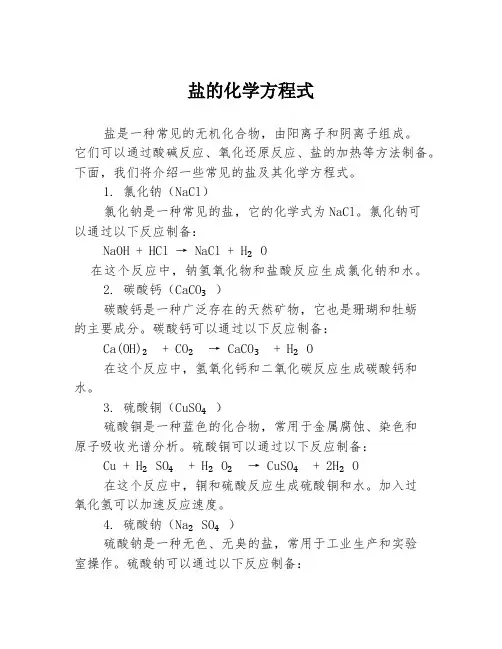
盐的化学方程式盐是一种常见的无机化合物,由阳离子和阴离子组成。
它们可以通过酸碱反应、氧化还原反应、盐的加热等方法制备。
下面,我们将介绍一些常见的盐及其化学方程式。
1. 氯化钠(NaCl)氯化钠是一种常见的盐,它的化学式为NaCl。
氯化钠可以通过以下反应制备:NaOH + HCl → NaCl + H₂O在这个反应中,钠氢氧化物和盐酸反应生成氯化钠和水。
2. 碳酸钙(CaCO₃)碳酸钙是一种广泛存在的天然矿物,它也是珊瑚和牡蛎的主要成分。
碳酸钙可以通过以下反应制备:Ca(OH)₂ + CO₂ → CaCO₃ + H₂O在这个反应中,氢氧化钙和二氧化碳反应生成碳酸钙和水。
3. 硫酸铜(CuSO₄)硫酸铜是一种蓝色的化合物,常用于金属腐蚀、染色和原子吸收光谱分析。
硫酸铜可以通过以下反应制备:Cu + H₂SO₄ + H₂O₂ → CuSO₄ + 2H₂O在这个反应中,铜和硫酸反应生成硫酸铜和水。
加入过氧化氢可以加速反应速度。
4. 硫酸钠(Na₂SO₄)硫酸钠是一种无色、无臭的盐,常用于工业生产和实验室操作。
硫酸钠可以通过以下反应制备:Na₂CO₃ + H₂SO₄ → Na₂SO₄ + CO₂ + H₂O在这个反应中,碳酸钠和硫酸反应生成硫酸钠、二氧化碳和水。
5. 硫酸铵(NH₄₂SO₄)硫酸铵是一种白色晶体,常用于制造氨、丝绸和合成纤维。
硫酸铵可以通过以下反应制备:2NH₃ + H₂SO₄ → (NH₄)₂SO₄在这个反应中,氨和硫酸反应生成硫酸铵。
6. 碘化钾(KI)碘化钾是一种白色固体,常用于化学实验室。
碘化钾可以通过以下反应制备:KOH + HI → KI + H₂O在这个反应中,氢氧化钾和碘化氢反应生成碘化钾和水。
以上是几种常见的盐及其化学方程式。
盐在我们的日常生活中起着重要的作用,这些化学方程式使我们深入理解了它们的制备和用途。
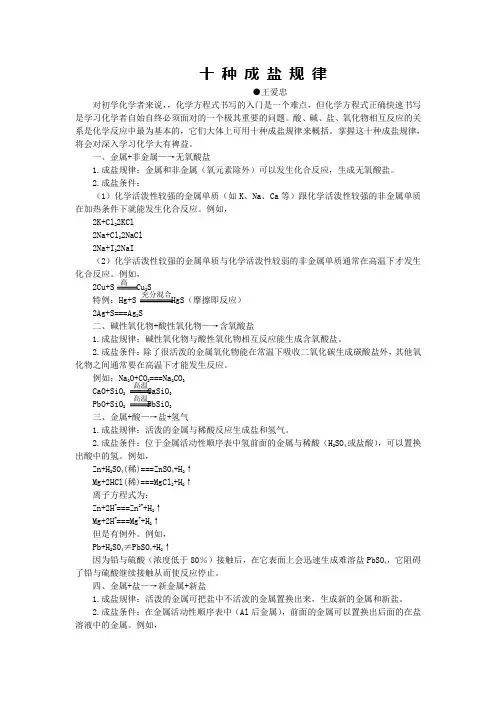
十 种 成 盐 规 律●王爱忠对初学化学者来说,,化学方程式书写的入门是一个难点,但化学方程式正确快速书写是学习化学者自始自终必须面对的一个极其重要的问题。
酸、碱、盐、氧化物相互反应的关系是化学反应中最为基本的,它们大体上可用十种成盐规律来概括。
掌握这十种成盐规律,将会对深入学习化学大有裨益。
一、金属+非金属—→无氧酸盐1.成盐规律:金属和非金属(氧元素除外)可以发生化合反应,生成无氧酸盐。
2.成盐条件:(1)化学活泼性较强的金属单质(如K 、Na 、Ca 等)跟化学活泼性较强的非金属单质在加热条件下就能发生化合反应。
例如,2K+Cl 22KCl2Na+Cl 22NaCl2Na+I 22NaI(2)化学活泼性较强的金属单质与化学活泼性较弱的非金属单质通常在高温下才发生化合反应。
例如, 2Cu+S Cu 2S 特例:Hg+S HgS (摩擦即反应)2Ag+S===Ag 2S二、碱性氧化物+酸性氧化物—→含氧酸盐1.成盐规律:碱性氧化物与酸性氧化物相互反应能生成含氧酸盐。
2.成盐条件:除了很活泼的金属氧化物能在常温下吸收二氧化碳生成碳酸盐外,其他氧化物之间通常要在高温下才能发生反应。
例如:Na 2O+CO 2===Na 2CO 3 CaO+SiO 2 CaSiO 3 PbO+SiO 2 PbSiO 3三、金属+酸—→盐+氢气1.成盐规律:活泼的金属与稀酸反应生成盐和氢气。
2.成盐条件:位于金属活动性顺序表中氢前面的金属与稀酸(H 2SO 4或盐酸),可以置换出酸中的氢。
例如,Zn+H 2SO 4(稀)===ZnSO 4+H 2↑Mg+2HCl(稀)===MgCl 2+H 2↑离子方程式为:Zn+2H +===Zn 2++H 2↑Mg+2H +===Mg ++H 2↑但是有例外。
例如,Pb+H 2SO 4≠PbSO 4+H 2↑因为铅与硫酸(浓度低于80%)接触后,在它表面上会迅速生成难溶盐PbSO 4,它阻碍了铅与硫酸继续接触从而使反应停止。

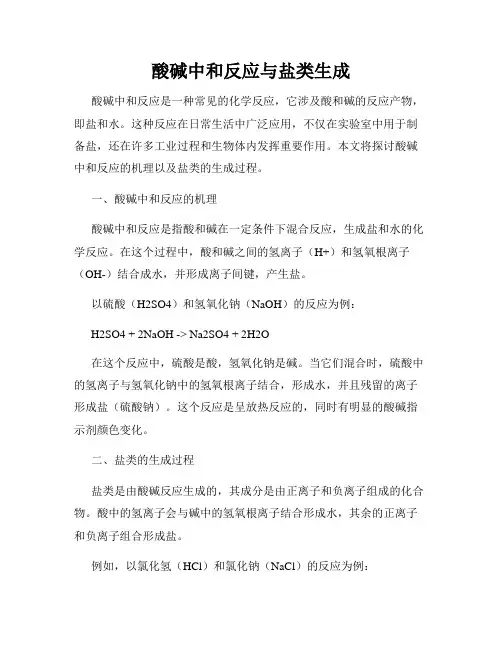
酸碱中和反应与盐类生成酸碱中和反应是一种常见的化学反应,它涉及酸和碱的反应产物,即盐和水。
这种反应在日常生活中广泛应用,不仅在实验室中用于制备盐,还在许多工业过程和生物体内发挥重要作用。
本文将探讨酸碱中和反应的机理以及盐类的生成过程。
一、酸碱中和反应的机理酸碱中和反应是指酸和碱在一定条件下混合反应,生成盐和水的化学反应。
在这个过程中,酸和碱之间的氢离子(H+)和氢氧根离子(OH-)结合成水,并形成离子间键,产生盐。
以硫酸(H2SO4)和氢氧化钠(NaOH)的反应为例:H2SO4 + 2NaOH -> Na2SO4 + 2H2O在这个反应中,硫酸是酸,氢氧化钠是碱。
当它们混合时,硫酸中的氢离子与氢氧化钠中的氢氧根离子结合,形成水,并且残留的离子形成盐(硫酸钠)。
这个反应是呈放热反应的,同时有明显的酸碱指示剂颜色变化。
二、盐类的生成过程盐类是由酸碱反应生成的,其成分是由正离子和负离子组成的化合物。
酸中的氢离子会与碱中的氢氧根离子结合形成水,其余的正离子和负离子组合形成盐。
例如,以氯化氢(HCl)和氯化钠(NaCl)的反应为例:HCl + NaOH -> NaCl + H2O在这个反应中,氯化氢是酸,氯化钠是盐。
当它们混合时,氯化氢中的氢离子与氢氧根离子结合,形成水,并形成盐(氯化钠)。
这个反应是无-color的反应,没有酸碱指示剂颜色的变化。
盐类的生成过程中,还有一些特殊的情况。
例如,碳酸氢钠(NaHCO3)和盐酸(HCl)的反应:NaHCO3 + HCl -> NaCl + H2O + CO2↑在这个反应中,碳酸氢钠是酸性物质,盐酸是酸,它们的混合不仅会生成盐(氯化钠),还会产生水和二氧化碳气体。
这种反应在烘焙过程中常被用于制作面包和蛋糕,二氧化碳气体的释放导致面团膨胀发酵,使烘焙食品更加松软。
总体来说,酸碱中和反应中的酸和碱会发生化学反应,生成盐和水。
而具体生成的盐种类取决于酸和碱的组成成分。
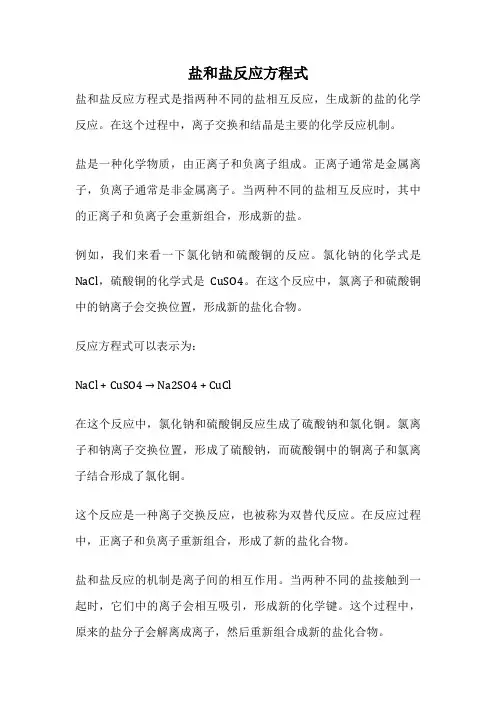
盐和盐反应方程式
盐和盐反应方程式是指两种不同的盐相互反应,生成新的盐的化学反应。
在这个过程中,离子交换和结晶是主要的化学反应机制。
盐是一种化学物质,由正离子和负离子组成。
正离子通常是金属离子,负离子通常是非金属离子。
当两种不同的盐相互反应时,其中的正离子和负离子会重新组合,形成新的盐。
例如,我们来看一下氯化钠和硫酸铜的反应。
氯化钠的化学式是NaCl,硫酸铜的化学式是CuSO4。
在这个反应中,氯离子和硫酸铜中的钠离子会交换位置,形成新的盐化合物。
反应方程式可以表示为:
NaCl + CuSO4 → Na2SO4 + CuCl
在这个反应中,氯化钠和硫酸铜反应生成了硫酸钠和氯化铜。
氯离子和钠离子交换位置,形成了硫酸钠,而硫酸铜中的铜离子和氯离子结合形成了氯化铜。
这个反应是一种离子交换反应,也被称为双替代反应。
在反应过程中,正离子和负离子重新组合,形成了新的盐化合物。
盐和盐反应的机制是离子间的相互作用。
当两种不同的盐接触到一起时,它们中的离子会相互吸引,形成新的化学键。
这个过程中,原来的盐分子会解离成离子,然后重新组合成新的盐化合物。
除了离子交换,盐和盐反应还涉及到结晶。
当反应产生的盐溶解在溶液中时,如果溶液中的盐浓度超过了饱和点,就会发生结晶反应,盐化合物会从溶液中析出形成固体晶体。
总结起来,盐和盐反应是指两种不同的盐相互作用,通过离子交换和结晶反应生成新的盐化合物。
这个过程中,原来的盐分子解离成离子,然后重新组合成新的盐化合物。
这种反应机制在化学研究和工业生产中具有重要的应用价值。
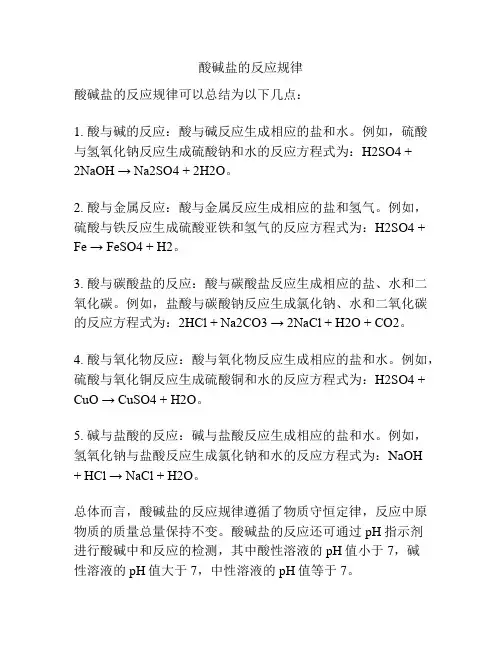
酸碱盐的反应规律
酸碱盐的反应规律可以总结为以下几点:
1. 酸与碱的反应:酸与碱反应生成相应的盐和水。
例如,硫酸与氢氧化钠反应生成硫酸钠和水的反应方程式为:H2SO4 +
2NaOH → Na2SO4 + 2H2O。
2. 酸与金属反应:酸与金属反应生成相应的盐和氢气。
例如,硫酸与铁反应生成硫酸亚铁和氢气的反应方程式为:H2SO4 + Fe → FeSO4 + H2。
3. 酸与碳酸盐的反应:酸与碳酸盐反应生成相应的盐、水和二氧化碳。
例如,盐酸与碳酸钠反应生成氯化钠、水和二氧化碳的反应方程式为:2HCl + Na2CO3 → 2NaCl + H2O + CO2。
4. 酸与氧化物反应:酸与氧化物反应生成相应的盐和水。
例如,硫酸与氧化铜反应生成硫酸铜和水的反应方程式为:H2SO4 + CuO → CuSO4 + H2O。
5. 碱与盐酸的反应:碱与盐酸反应生成相应的盐和水。
例如,氢氧化钠与盐酸反应生成氯化钠和水的反应方程式为:NaOH + HCl → NaCl + H2O。
总体而言,酸碱盐的反应规律遵循了物质守恒定律,反应中原物质的质量总量保持不变。
酸碱盐的反应还可通过pH指示剂
进行酸碱中和反应的检测,其中酸性溶液的pH值小于7,碱
性溶液的pH值大于7,中性溶液的pH值等于7。

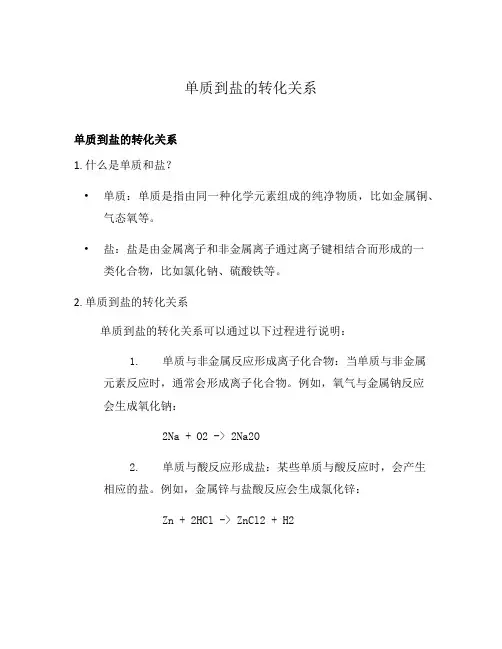
单质到盐的转化关系单质到盐的转化关系1. 什么是单质和盐?•单质:单质是指由同一种化学元素组成的纯净物质,比如金属铜、气态氧等。
•盐:盐是由金属离子和非金属离子通过离子键相结合而形成的一类化合物,比如氯化钠、硫酸铁等。
2. 单质到盐的转化关系单质到盐的转化关系可以通过以下过程进行说明:1.单质与非金属反应形成离子化合物:当单质与非金属元素反应时,通常会形成离子化合物。
例如,氧气与金属钠反应会生成氧化钠:2Na + O2 -> 2Na2O2.单质与酸反应形成盐:某些单质与酸反应时,会产生相应的盐。
例如,金属锌与盐酸反应会生成氯化锌:Zn + 2HCl -> ZnCl2 + H23.单质与氧化剂反应形成盐:一些金属单质与氧化剂(比如过氧化氢)反应时,也会生成相应的盐。
例如,铁与过氧化氢反应会生成铁(III)盐:2Fe + 3H2O2 -> 2Fe(III) + 3H2O4.单质与酸性氧化物反应形成盐:一些金属单质与酸性氧化物(含氧量较高的物质,比如二氧化硫)反应也能生成盐。
例如,铜与二氧化硫反应会生成红色的硫酸铜:Cu + SO2 -> CuSO45.单质与非金属氧化物反应形成盐:某些金属单质与非金属氧化物反应时,也能生成相应的盐。
例如,钠与硫反应会生成硫化钠:2Na + S -> Na2S结论单质与盐的转化关系非常广泛,可以通过与非金属、酸、氧化剂、酸性氧化物以及非金属氧化物等的反应来实现。
这些转化过程在化学反应中起着重要作用,既能合成盐,也能提供不同性质和应用的化合物。
3. 解释说明单质到盐的转化关系是化学反应中一种常见的转化过程。
在这个过程中,单质与其他化合物或元素发生反应,形成新的化合物,即盐。
单质可以是金属或非金属元素,而盐一般是由金属离子和非金属离子通过离子键相结合而形成的化合物。
单质与非金属元素反应时,通常会形成离子化合物。
例如,氧气与金属钠反应会生成氧化钠(Na2O)。
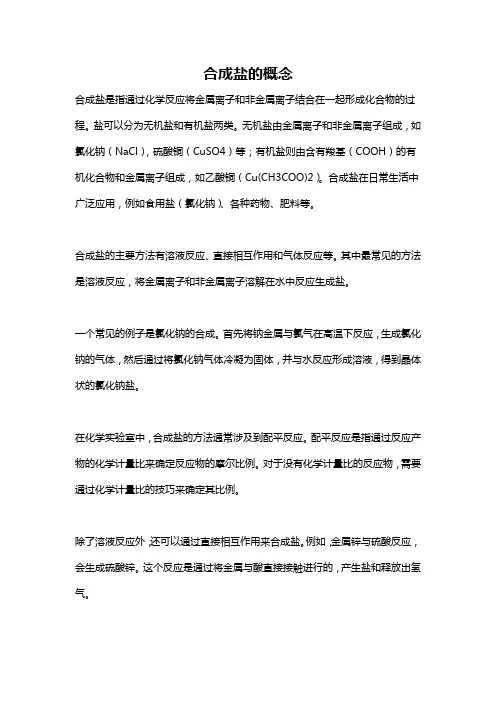
合成盐的概念合成盐是指通过化学反应将金属离子和非金属离子结合在一起形成化合物的过程。
盐可以分为无机盐和有机盐两类。
无机盐由金属离子和非金属离子组成,如氯化钠(NaCl),硫酸铜(CuSO4)等;有机盐则由含有羧基(COOH)的有机化合物和金属离子组成,如乙酸铜(Cu(CH3COO)2)。
合成盐在日常生活中广泛应用,例如食用盐(氯化钠)、各种药物、肥料等。
合成盐的主要方法有溶液反应、直接相互作用和气体反应等。
其中最常见的方法是溶液反应,将金属离子和非金属离子溶解在水中反应生成盐。
一个常见的例子是氯化钠的合成。
首先将钠金属与氯气在高温下反应,生成氯化钠的气体,然后通过将氯化钠气体冷凝为固体,并与水反应形成溶液,得到晶体状的氯化钠盐。
在化学实验室中,合成盐的方法通常涉及到配平反应。
配平反应是指通过反应产物的化学计量比来确定反应物的摩尔比例。
对于没有化学计量比的反应物,需要通过化学计量比的技巧来确定其比例。
除了溶液反应外,还可以通过直接相互作用来合成盐。
例如,金属锌与硫酸反应,会生成硫酸锌。
这个反应是通过将金属与酸直接接触进行的,产生盐和释放出氢气。
气体反应也可以用来合成盐。
例如,氢气和氯气可以通过电火花反应生成盐酸。
这个反应可以通过将氯气和氢气通入一个反应容器,然后通过电火花来引发反应,生成盐酸和水。
合成盐的应用非常广泛。
食用盐是最常见的应用之一。
食用盐是由氯化钠制成的,它是维持正常体液平衡和神经肌肉活动所必需的。
此外,盐也被广泛用于制药、农业等领域。
药物中常用的盐包括硫酸铁、硫酸镁等,它们常用于治疗贫血、缺镁症等疾病。
在农业中,氯化钾、硝酸钠等盐被用作肥料,它们提供植物所需的营养元素。
合成盐的过程涉及到化学原理和实验技术。
在实验室中,合成盐的过程需要控制反应条件,例如温度、压力、反应时间等。
此外,溶液的浓度、溶剂的选择等也需要进行合理的设计。
总之,合成盐是将金属离子和非金属离子通过化学反应结合在一起形成盐的过程。
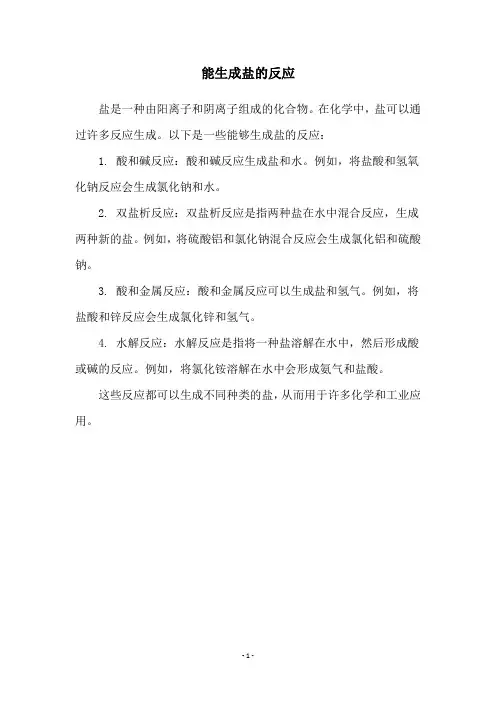
能生成盐的反应
盐是一种由阳离子和阴离子组成的化合物。
在化学中,盐可以通过许多反应生成。
以下是一些能够生成盐的反应:
1. 酸和碱反应:酸和碱反应生成盐和水。
例如,将盐酸和氢氧化钠反应会生成氯化钠和水。
2. 双盐析反应:双盐析反应是指两种盐在水中混合反应,生成两种新的盐。
例如,将硫酸铝和氯化钠混合反应会生成氯化铝和硫酸钠。
3. 酸和金属反应:酸和金属反应可以生成盐和氢气。
例如,将盐酸和锌反应会生成氯化锌和氢气。
4. 水解反应:水解反应是指将一种盐溶解在水中,然后形成酸或碱的反应。
例如,将氯化铵溶解在水中会形成氨气和盐酸。
这些反应都可以生成不同种类的盐,从而用于许多化学和工业应用。
- 1 -。
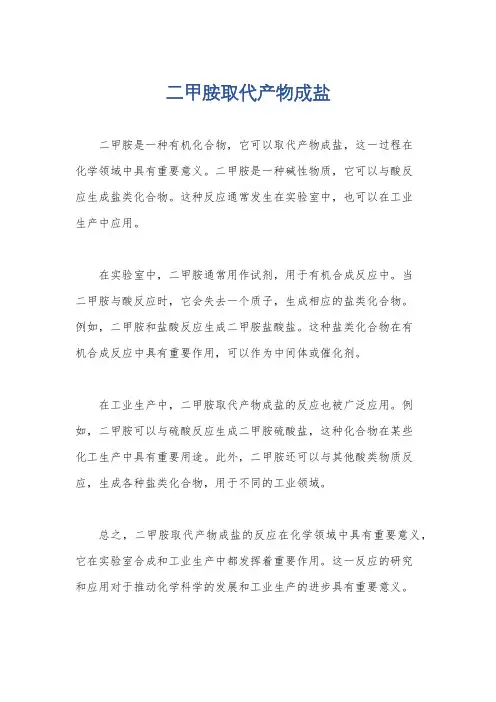
二甲胺取代产物成盐
二甲胺是一种有机化合物,它可以取代产物成盐,这一过程在
化学领域中具有重要意义。
二甲胺是一种碱性物质,它可以与酸反
应生成盐类化合物。
这种反应通常发生在实验室中,也可以在工业
生产中应用。
在实验室中,二甲胺通常用作试剂,用于有机合成反应中。
当
二甲胺与酸反应时,它会失去一个质子,生成相应的盐类化合物。
例如,二甲胺和盐酸反应生成二甲胺盐酸盐。
这种盐类化合物在有
机合成反应中具有重要作用,可以作为中间体或催化剂。
在工业生产中,二甲胺取代产物成盐的反应也被广泛应用。
例如,二甲胺可以与硫酸反应生成二甲胺硫酸盐,这种化合物在某些
化工生产中具有重要用途。
此外,二甲胺还可以与其他酸类物质反应,生成各种盐类化合物,用于不同的工业领域。
总之,二甲胺取代产物成盐的反应在化学领域中具有重要意义,它在实验室合成和工业生产中都发挥着重要作用。
这一反应的研究
和应用对于推动化学科学的发展和工业生产的进步具有重要意义。
胺类化合物是一类含有氮原子的有机化合物,可以通过盐形式进行纯化。
以下是一种常用的方法:胺类化合物与酸反应生成相应的盐,然后通过结晶、过滤和洗涤等步骤来纯化。
1.选择适当的酸:根据目标胺化合物的性质选择合适的酸。
常用的酸包括盐酸(HCl)、
硫酸(H2SO4)等。
2.酸化反应:将胺类化合物与所选酸反应。
在反应过程中,可以添加适量的溶剂以促进反
应的进行。
通常需要将胺和酸以摩尔比1:1的比例混合。
3.结晶:酸化反应后,目标盐会在溶液中结晶沉淀。
可以通过降低温度或搅拌来促使结晶
的发生。
4.过滤:将结晶沉淀的盐通过过滤器筛除,分离出来。
5.洗涤:用适量的冷溶剂洗涤盐的结晶沉淀,以去除杂质和未反应的酸。
6.干燥:将洗涤干净的盐在低温下干燥,去除溶剂,得到纯净的胺类盐。
需要注意的是,在进行胺类化合物盐纯化时,应注意操作安全,并遵循适当的实验室规范和操作方法。
此外,不同的胺类化合物可能需要根据其特性和反应条件进行调整。
建议在实验室或专业人员指导下进行相关实验。
金属和非金属反应生成盐的化学方程式示例文章篇一:《金属和非金属反应生成盐:化学世界的奇妙组合》嘿,你知道化学这个神奇的世界吗?今天我想和你讲讲金属和非金属反应生成盐的那些事儿。
在化学里,金属就像是一个个英勇的小战士,而非金属呢,有的像调皮的小精灵。
当它们碰到一起的时候,就会发生超级有趣的反应,然后就生成了盐。
这就好比是两个不同的小伙伴,一个强壮有力(金属),一个古灵精怪(非金属),他们一结合,就变成了一种全新的东西,就像把红色的颜料和蓝色的颜料混合起来,会变成紫色一样神奇。
我先来说说最常见的,钠和氯气的反应吧。
钠这个金属呀,可活泼啦。
它就像一个充满活力、一刻也停不下来的小男孩。
氯气呢,是一种黄绿色的气体,就像一个神秘的小绿怪。
当钠和氯气相遇的时候,哇,那可不得了。
钠原子就把自己的一个电子给了氯原子,你想啊,这就好像是钠这个大方的小伙伴把自己心爱的小玩具送给了氯气这个小伙伴。
然后呢,钠就变成了钠离子,氯就变成了氯离子,它们两个就紧紧地抱在一起,形成了氯化钠,这就是我们平常吃的盐啦。
这个反应的化学方程式是2Na + Cl₂ = 2NaCl。
你看,简简单单的几个符号,就把这么奇妙的过程表示出来了。
再来说说镁和氧气的反应吧。
镁是一种银白色的金属,看起来特别闪亮,就像一颗银色的星星。
氧气呢,我们每天都离不开它,它就像一个隐形的保护罩围绕着我们。
镁在空气中燃烧的时候,那场面可壮观了。
镁和氧气反应,镁原子失去两个电子,变成镁离子,氧原子得到两个电子变成氧离子,然后它们就结合成了氧化镁。
化学方程式是2Mg + O₂ = 2MgO。
这就好像是镁这个闪亮的小明星和氧气这个隐形的伙伴一起跳起了一支独特的舞蹈,最后融合成了新的氧化镁。
还有铝和硫的反应呢。
铝是一种很轻但是很结实的金属,就像一个小巧但坚韧的小超人。
硫呢,是一种黄色的固体,有点像一颗黄色的小宝石。
当铝和硫反应的时候,铝原子会把电子给硫原子,然后它们就变成了硫化铝。
反应成盐过程怎么控制粒度大小的方法嘿,咱今儿就来聊聊反应成盐过程中怎么控制粒度大小这档子事儿!你想想看啊,就好比咱包饺子,那饺子皮儿得大小合适吧,不然包出来的饺子不是大了就是小了,多难看呀!这反应成盐过程中的粒度大小就跟饺子皮儿差不多重要呢!那要怎么控制呢?首先啊,温度可不能小瞧。
温度就像是个魔法师,能对粒度大小施魔法呢!温度太高或太低,那可都不行。
太高了,那颗粒可能就跟发疯了似的,长得乱七八糟,大大小小不均匀;太低了呢,嘿,它们又懒得动弹,半天长不出个合适的大小来。
所以啊,得找到那个刚刚好的温度点,让颗粒乖乖地长成咱想要的大小。
还有搅拌呢!搅拌就像是给颗粒们做按摩,力度和频率都得恰到好处。
搅拌太轻了,那颗粒们就会挤在一块儿,长成大块头;搅拌太重了,又会把它们给打散了,变得小小的。
你说这多麻烦呀!所以得掌握好那个搅拌的度,让颗粒们舒舒服服地长大。
反应时间也很关键呀!时间短了,颗粒还没来得及好好长呢;时间长了,说不定又长过头啦!这就跟煮鸡蛋似的,时间短了没熟,时间长了又老了。
得掐准那个时间,让颗粒正好长成理想的粒度。
再说说反应物的浓度吧。
浓度高了,颗粒们就像吃多了似的,长得胖乎乎的;浓度低了,它们又没得吃,长不起来。
这可咋整?那就得精心调配反应物的浓度,让颗粒们吃得饱饱的,长得壮壮的,但又不会太胖。
咱可不能马虎对待这些呀!要是不注意,那最后得到的可不是咱想要的东西。
就好比你去种花儿,你不好好照顾,能长出漂亮的花儿来吗?那肯定不行呀!总之呢,要想在反应成盐过程中控制好粒度大小,就得像照顾宝贝似的,方方面面都得考虑到。
温度、搅拌、反应时间、反应物浓度,一个都不能少!只有这样,咱才能得到咱满意的粒度大小,才能让反应成盐过程顺顺利利的呀!咱可不能在这上面掉以轻心,不然到时候后悔都来不及啦!你说是不是这个理儿?。
成盐反应条件咱今天就来好好唠唠成盐反应的条件。
这成盐反应啊,在化学里可是挺重要的一块呢。
成盐反应就是酸和碱反应生成盐和水的过程。
那要让这个反应顺利进行,都需要啥条件呢?温度就是一个很重要的条件。
不同的成盐反应对温度的要求不太一样。
有些反应在常温下就能进行得很顺利,可有些反应呢,可能就需要稍微高一点的温度。
比如说,有些酸和碱在常温下反应比较慢,这时候稍微给点温度,反应速度就能加快不少。
但也不是温度越高就越好哦,温度太高了可能会导致一些副反应发生,或者让生成的盐不稳定。
所以啊,得根据具体的反应来选择合适的温度。
浓度也很关键呢。
如果酸和碱的浓度太低,反应可能就会比较慢,甚至可能不明显。
但浓度也不能太高,太高的话可能会有危险,而且也可能会影响反应的选择性。
比如说,浓度太高可能会导致生成一些不想要的副产物。
所以,要找到一个合适的浓度范围,让反应既能够快速进行,又能得到比较纯的盐。
反应时间也不能忽视。
有些反应很快,一会儿就完成了;但有些反应可能需要比较长的时间。
如果反应时间太短,可能反应不完全,得到的盐不纯。
可要是反应时间太长呢,又浪费时间和能源。
所以,要根据不同的反应来确定合适的反应时间。
还有啊,搅拌也很重要。
搅拌可以让酸和碱充分接触,加快反应速度。
如果不搅拌,反应可能只在局部进行,导致反应不均匀。
而且,搅拌还可以让生成的热量均匀散发,避免局部过热。
反应物的纯度也会影响成盐反应。
如果反应物里有杂质,可能会干扰反应,或者生成一些不想要的副产物。
所以,在进行成盐反应之前,最好把反应物提纯一下,保证它们的纯度。
最后,反应的环境也有影响哦。
比如说,有些反应在酸性环境下更容易进行,有些则在碱性环境下更好。
还有些反应对空气、水分比较敏感,这时候就得在特定的环境下进行反应,比如在干燥的氮气氛围中。
成盐反应的条件有很多,温度、浓度、反应时间、搅拌、反应物纯度和反应环境等等都很重要。
要想让成盐反应顺利进行,得到高质量的盐,就得仔细考虑这些条件,根据具体的反应来选择最合适的条件。
顺式环己二胺和二氧化碳成盐顺式环己二胺是一种重要的有机化合物,被广泛应用于医药、染料和农药等领域。
而二氧化碳是一种常见的无机化合物,广泛存在于大气中。
这两种化合物在一定条件下可以发生反应,形成环己二胺盐酸盐。
当顺式环己二胺与二氧化碳反应时,首先需要提供适当的反应条件和催化剂。
一般来说,这种反应需要在相对较高的温度下进行,并加入一定量的催化剂,如五氧化二磷或三乙胺等。
这些催化剂有助于加速反应速度和提高产率。
在反应过程中,顺式环己二胺的氨基与二氧化碳中的羰基发生亲核加成反应。
亲核反应是一种化学反应,其中亲核剂通过给予电子对,与亲电子中心形成新的化学键。
在这个反应中,顺式环己二胺的氨基起到亲核剂的作用,而二氧化碳中的羰基则是亲电子中心。
在反应完成后,生成的产物是环己二胺盐酸盐。
这是一种盐状固体,其化学式为C6H14N2·HCl。
这种盐酸盐具有良好的稳定性和溶解性,可以方便地用于实验室和工业生产中。
顺式环己二胺和二氧化碳成盐的反应具有重要的应用价值。
首先,这种反应为环己二胺的合成提供了一种新的方法。
其次,环己二胺盐酸盐可以作为一种中间体,在有机合成中发挥重要作用。
此外,环己二胺盐酸盐还可以用作金属离子的络合剂,具有一定的药理活性。
顺式环己二胺和二氧化碳成盐的反应是一种重要的化学反应,具有广泛的应用前景。
通过合理的反应条件和催化剂的选择,可以高效地实现这种反应,并得到理想的产物。
这种反应不仅在有机合成领域有重要意义,还为环境保护和资源利用提供了新的思路。
我们相信,在未来的研究中,这种反应将得到更加深入的探索和应用。
盐和盐的反应盐,是由酸和碱在相互反应时生成的,是化学反应中常见的一种物质。
常见的食用盐为氯化钠(NaCl),其盐酸和硫酸相互反应而成,同时还有许多其他种类的盐。
在化学反应中,盐通常被认为是一种离子化合物。
在酸和碱反应的过程中,酸中的氢离子与碱中的氢氧根离子结合而形成盐。
盐的形成是一种中和反应,酸的酸度指数与碱的碱度指数相等,即酸碱中和。
盐不是一种活泼而独特的化合物,而是由两种相反的离子组成的,一个是阳离子,一个是阴离子。
这两种离子在形成盐时结合在一起,盐可以通过化学反应慢慢分解,其中一种离子以便与其他物质结合形成新的化合物。
盐和水的反应将盐溶于水中,会引起水对盐的溶解,形成离子。
当离子与水分子相互作用时,就会发生化学反应。
当盐溶解在水中时,会形成两种离子:正离子和负离子。
当负离子与水分子相互作用时,会形成氢氧根离子(OH-),而正离子则会与水分子中的氢离子(H+)相互作用,形成酸性盐。
例如,氯离子(Cl-)和水分子会发生化学反应,形成氢氧根离子和氯化氢酸(HCl)。
Cl- + H2O → HCl + OH-这种反应大多数情况下是不可逆反应,但在极端情况下,如蒸发水时,可以将盐从溶解到水中的状态恢复到其固体形态。
盐和酸的反应一些盐在与酸反应时会产生化学反应。
当盐中的阴离子具有弱碱性时,将会发生中和反应,阴离子将与酸中的氢离子结合形成水。
例如,乙酸钠(NaC2H3O2)和盐酸(HCl)中和反应时,产生水和氯化钠(NaCl)NaC2H3O2 + HCl → NaCl + H2O + C2H4O2盐和酸的反应也可以形成酸盐。
当酸中的氢离子只与盐中的一部分阴离子结合时,就会形成酸盐。
例如,硫酸钠(Na2SO4)和盐酸中和反应时,产生氯化钠和硫酸钠。
Na2SO4 + 2HCl → 2NaCl + H2SO4盐的还原性一些金属盐具有还原性,这意味着它们可以用作还原剂,在化学反应中失去一个或多个电子。
例如,铁盐具有还原性,因此可以用作还原剂。
QueryQuery Results Date1. Query 19 reactions in2014-11-18 01h:54m:50s (EST)ReaxysSearch as: Product, As drawn, No salts, No mixtures色氨酸甲酯盐酸盐的制备在冰浴下,增加了100毫升圆底烧瓶与60毫升的甲醇,然后慢慢加4毫升SOCl2 恒压滴液漏斗(干燥管顶部),和氢氧化钠溶液吸收废气。
搅拌1小时后,8mmol的色氨酸(3 d)补充道,在室温下搅拌30分钟,然后回流在66°c 6 h。
反应是由薄层色谱跟踪,直到原料消失,2%茚三酮在乙醇溶液为显色剂。
溶剂蒸发了获得色氨酸甲酯盐酸盐。
收益率:100%。
+→Rx-ID: 3829969 View in Reaxys 1/19 Yield Conditions & References100 % thionyl chloride, Time= 4h, Heating; Tetrahedron; 57; nb. 51; (2001); p. 10181 - 10189View in Reaxys100 %(2) Preparation of L-Tryptophan Methyl Ester Hydrochloride Under ice bath, 100 ml round-bottom flask was addedwith 60 ml of methanol, and then slowly added with 4 ml of SOClthrough constant pressure dropping funnel (with adrying tube on the top), and NaOH solution was used to absorb exhaust. After stirring for 1 h, 8 mmol of L-tryptophan (3d) was added and stirred at room temperature for 30 min, and then refluxed at 66° C. for 6 h. Thereaction was tracked by TLC until the raw material disappears, with a solution of 2percent ninhydrin in ethanol aschromogenic reagent. The solvent was evaporated out to obtain L-tryptophan methyl ester hydrochloride. Yield:100percent.thionyl chloride methanol, ethanol, Time= 1h, Cooling with ice, Time= 6.5h, T= 20 - 66 °C; ; US2014/206741; (2014); (A1) English View in Reaxys98 % thionyl chloride, Time= 8h, Heating; Organic Preparations and Procedures International; 33; nb. 4; (2001); p. 341 - 349View in Reaxys98 % thionyl chloride, T= 0 - 60 °C; ACS Medicinal Chemistry Letters; 4; nb. 2; (2013); p. 235 - 238View in Reaxys97 % thionyl chloride, Time= 24h, T= -15 - 20 °C , Saturated gas, Inert atmosphere; Chemical Communications; 50; nb. 23; (2014); p. 3052 - 3054View in Reaxys96 % thionyl chloride, Time= 0.666667h, T= 25 - 30 °C , microwave irradiation; Indian Journal of Chemistry - Section B Organic and Medicinal Chemistry; 45; nb. 8; (2006); p. 1942 - 1944Viewin Reaxys95 % acetyl chloride; Journal of Medicinal Chemistry; 57; nb. 8; (2014); p. 3324 - 3341View in Reaxys93 % thionyl chloride, T= 5 °C , RefluxTime= 4h, Reflux; Chirality; 25; nb. 10; (2013); p. 656 - 662View in Reaxys92 % thionyl chloride, Time= 6.5h, T= -10 - 25 °C; Journal of Chemical Information and Modeling; 53; nb. 1; (2013); p. 176 - 187View in Reaxys73 % thionyl chloride, Time= 7h, T= 60 - 70 °C; Bioorganic and Medicinal Chemistry; 15; nb. 14; (2007); p. 4903 - 4909View in Reaxys67 % thionyl chloride, Time= 9h, T= 20 °C; Dalton Transactions; 40; nb. 18; (2011); p. 5018 - 5025View in Reaxys63 % hydrogenchloride, T= 0 °C; Archiv der Pharmazie; 344; nb. 8; (2011); p. 494 - 504View in Reaxysthionyl chloride, Ambient temperature; Heterocycles; 32; nb. 10; (1991); p. 1879 - 1895View in Reaxysthionyl chloride, Time= 15h, Heating; European Journal of Medicinal Chemistry; 21; nb. 4; (1986); p. 333 - 338View in Reaxysthionyl chloride, Time= 18h, Heating, Yield given; Canadian Journal of Chemistry; 66; (1988); p. 779 - 782View in Reaxysacetyl chloride, Time= 4h, Heating; Synthetic Communications; 25; nb. 4; (1995); p. 561 - 568View in Reaxysthionyl chloride, 1.) -15 deg, 1 h, 2.) overnight, Yield given. Multistep reaction; Tetrahedron: Asymmetry; 6; nb. 8; (1995); p. 1947 - 1956View in Reaxysthionyl chloride, Time= 18h, Heating; Journal of Physical Organic Chemistry; 9; nb. 9; (1996); p. 639 - 644View in Reaxysthionyl chloride; Bioorganic and Medicinal Chemistry; 7; nb. 6; (1999); p. 1223 - 1236View in Reaxysthionyl chloride, T= -30 - -10 °C; Tetrahedron; 57; nb. 20; (2001); p. 4437 - 4442View in Reaxys3.84 g thionyl chloride, Time= 48h, T= 20 °C; Indian Journal of Chemistry - Section B Organic and Medicinal Chemistry; 45; nb. 12; (2006); p. 2710 - 2715Viewin Reaxysthionyl chloride, Time= 6h; Tetrahedron; 63; nb. 31; (2007); p. 7334 - 7348View in Reaxysthionyl chloride, T= -42 °C; Bioorganic and Medicinal Chemistry Letters; 18; nb. 21; (2008); p. 5750 - 5752View in Reaxysthionyl chloride, T= 20 °C , Cooling; Chemistry - A European Journal; 14; nb. 35; (2008); p. 10888 - 10891View in Reaxysthionyl chloride, Time= 7h, T= 60 - 70 °C; European Journal of Medicinal Chemistry; 44; nb. 10; (2009); p. 3922 - 3929View in Reaxysthionyl chloride, Time= 2.5h, T= 0 °C , Reflux, Inert atmosphere; Tetrahedron; 66; nb. 45; (2010); p. 8722 - 8728View in Reaxysthionyl chloride; European Journal of Organic Chemistry; nb. 14; (2008); p. 2423 - 2429View in Reaxys; Zeitschrift furAnorganische und Allgemeine Chemie; 636; nb. 1; (2010); p. 236 - 241View in Reaxysthionyl chloride; Journal of Chemical Research; 35; nb. 1; (2011); p. 47 - 50View in Reaxys; Journal of Chemical Research; 36;nb. 4; (2012); p. 206 - 209View in Reaxysthionyl chloride, T= 0 - 25 °C; Chemistry - An Asian Journal; 6; nb. 1; (2011); p. 189 - 197View in Reaxysthionyl chloride; Letters in Organic Chemistry; 8; nb. 3; (2011); p. 210 - 215View in Reaxysthionyl chloride, T= 60 - 70 °C; Journal of Enzyme Inhibition and Medicinal Chemistry; 26; nb. 5; (2011); p. 688 - 695View in Reaxysthionyl chloride, Reflux; Journal of Peptide Science; 18; nb. 8; (2012); p. 535 - 540View in ReaxysExample 7 Synthesis of Amide 7: N-(D)-tryptophanamide of AmB In another preferred embodiment the inventionprovides the AmB analogue denominated amide 7: N-(D)-tryptophanamide of AmB, represented by formula VII;using D-tryptophan as the starting amine. Fort this derivative the same structural aspects of the synthesis of amide6 were taken into account and it was observed in its synthesis the possible effect on the antibiotic activity that hasthe change in the stereochemistry of this derivative regarding amide 6. For L-tryptophan and D-tryptophan, beforethe amide synthesis, it was necessary to perform the sterification reaction of the carboxylic acid to protect it in formof hydrochloride of the methyl ester of tryptophan. This synthesis was performed by reacting 1 equivalent of theamino acid L-tryptophan or D-tryptophan (L-Trp or D-Trp) with excess MeOH and 2 equivalents of Me3SiCl toprocure the white precipitate of the hydrochloride of the methyl ester of L-tryptophan or D-tryptophan. Scheme 6shows the reaction mechanism proposed for this synthesis. The first step in the reaction consists of thenucleophilic addition of the tryptophan carboxyl function (E) on the Si of MeSiCl (F) inducing the displacement ofthe Cl ion. The silicon esters (intermediates G and H) are in an equilibrium in which it is proposed that thedeprotonated form is more susceptible to the nucleophilic addition of MeOH. This will form the hydrochloride of themethyl ester tryptophan with trymethylsilanol as a byproduct of the reaction. The hydrochloride of the tryptophanmethyl ester is used for the synthesis of the amides of AmB incorporating only an excess of EtN as basic reagentin the method of Jarzebski. This liberates the form of the methyl ester of the tryptophan to act as amine in thereaction. It is reported that by incorporating the tryptophan structure in AmB polyene molecules they fluoresceunder UV light. The tryptophan methyl ester was used for the synthesis of AmB amides as a means to procureamides that fluoresce under UV light. This is a desirable characteristic for experiments of electrophysiology in unitchannel as because of this, the channels would present this type of fluorescence. Characterization of Amide N-(D)-tryptophanamide of AmB. The IR spectrum of the product is almost identical to that of amide 6, showing onlyslight differences in the intensity of the signals. The derivative had a value of R=0.62 for which it is qualitativelyconsidered that this product is non-polar regarding AmB. These two results help confirm that amide 7 has the samestructure of amide 6, and its epimer. During the process of purification of amide 7 two products were isolated:amide 7a and amide 7b. The IR spectra of both amides have a similar difference to that of amide 2a and amide 2bin the absorption band of the polyhydroxylated chain. Here the difference in the intensity of the bands is not toolarge. Because of this it is believed that this is the same structure, and it is supposed that the solvation with ether(of the purification) occurred in the polyhydroxylated chain for the amide 7b. Moreover, it is likely that the antibioticbehavior is diminished because the actual concentration of the derivative could be less than that contemplated inthe preparation of the amide solution. It is noteworthy that the rest of the spectra of both products are the same.Here, being the epimer (D) of the N-(L)-tryptophanamide, the same values of the derivative 6 are contemplated.Therefore, this synthesis is to determine whether the difference the epimers (L)-(D) stereochemistry will affect theantibiotic activity.chloro-trimethyl-silane; ; US2014/256663; (2014); (A1) English View in Reaxys+→Rx-ID: 3830149 View in Reaxys 2/19 Yield Conditions & References100 % thionyl chloride, Time= 4h, Heating; Tetrahedron; 57; nb. 51; (2001); p. 10181 - 10189View in Reaxys98 % Synthesis of methyl esters of L- and D-tryptophanes chlorohydrates; :1a,b 2a,b a : D b : L[0344] Thionylchloride(0.064 mol) was slowly added to a cooled (OC) suspension of tryptophane (0.049 mol) in methanol (150 mL). Thereaction mixture was warmed up to 4OC and stirred at this temperature for six hours. All solvents were removedand the solid residue was triturated with ether. The solid was filtered off to give the required product.[0345] D-tryptophane (2a): yield 98 percent, M.p. 232-233°C. NMRH (δ, ppm,DMSO-dψ, 300 MHz): 3.39 (2H, m, CH); 3.63(3H, s, CHO); 4.20 (1 H t, CH, J = 5.5 Hz); 7.07 (2H, dt, Ar, J = 21 Hz, 6 Hz); 7.26 (1 H, d, H, JH = 3 Hz); 7.39 (1 H,d, Ar, JH = 7.8 Hz); 7.53 (1 H, d, Ar, J = 7.8 Hz). NMRC (δ, ppm, DMSO-d6, 125.76 MHz): 26.01 (s), 52.61 (d),106.26(s), 111.45(s), 117.84(s), 118.50(s), 121.05(s), 124.80(s), 126.79(s), 136.13(s), 169.57(s). / 218(M).thionyl chloride, Time= 6h, T= 0 - 40 °C; ; WO2008/103470; (2008); (A2) English View in Reaxys97 % thionyl chloride, Time= 4h, T= 40 °C; RSC Advances; 4; nb. 3; (2014); p. 1204 - 1211View in Reaxys92.4 %thionyl chloride methanol, Time= 1 - 2h, Heating / reflux; ; WO2004/11463; (2004); (A1) English View in Reaxys92 % thionyl chloride, Time= 6.5h, T= -10 - 25 °C; Journal of Chemical Information and Modeling; 53; nb. 1; (2013); p. 176 - 187View in Reaxys86 % thionyl chloride, Time= 24h, Reflux; Organic and Biomolecular Chemistry; 11; nb. 19; (2013); p. 3255 - 3260View in Reaxys86 % Thionyl chloride (9.87 mmol, 0.72 mL) was added dropwise to a solution of D-tryptophan (1.000 g, 4.89 mmol) inmethanol (33 mL). The reaction was heated to reflux with vigorous stirring for 24 h. After cooling, the reactionmixture was concentrated under reduced pressure and residual methanol traces removed by azeotropic distillationwith dichloromethane (10 mL) under reduced pressure to give the title compound as a white solid (1.070 g,86percent). [0401] H NMR (500 MHz, DO) δ=7.52 (1H, d, J=7.9, 9-H), 7.46 (1H, d, J=8.1, 12-H), 7.26-7.10 (3H, m,4, 5, 9-H), 4.37 (1H, t, J=6.0, 2-H), 3.73 (3H, s, β-H), 3.44-3.31 (2H, m, 4-H). [0402] C NMR (126 MHz, DO)δ=170.4 (2-C), 136.3 (7-C), 126.4 (8-C), 125.4 (6-C), 122.3 (11-CH), 119.6 (10-CH), 118.1 (9-CH), 112.1 (12-CH),106.0 (5-C), 53.6 (13-CH), 53.3 (2-CH), 25.7 (4-CH). [0403] IR (diamond, v, cm) 3261 (NH st), 2870 (N-H st), 2023(Ar comb), 1748 (C═O st), 1229, 1211 (CO—O st as), 1181 (C—O st as). [0404] Acc. Mass (FAB): CHNOFound:219.1120 m/z Calculated: 219.1128 m/z.thionyl chloride, Time= 24h, Reflux; ; US2014/39200; (2014); (A1) English View in Reaxys80 % D-tryptophan (100 g) was suspended in methanol (500 mL) and the suspension added to a solution of thionylchloride (82.14 g) in methanol (500 mL) at 25-30° C under nitrogen atmosphere. The resultant solution was stirredat reflux for 3 to 4 hours and the reaction mixture was concentrated to a residual volume of 150 mL. To theconcentrated mixture dichloromethane (700 mL) was added and the resultant solution was cooled to 0- 5° C withcontinuous stirring for 0.5 hours. The solid so obtained was filtered, washed with dichloromethane (200 mL) anddried in air at 40-45° C to afford D-tryptophan methyl ester hydrochloride.Yield: 10O g (80percent)thionyl chloride, Time= 3 - 4h, T= 25 - 30 °C , Heating / reflux; ; WO2009/4557; (2009); (A2) English View in Reaxysthionyl chloride, Time= 18h, Heating, Yield given; Canadian Journal of Chemistry; 66; (1988); p. 779 - 782View in Reaxysthionyl chloride, Time= 0.5h, T= 0 °C Heating; Journal of Medicinal Chemistry; 49; nb. 24; (2006); p. 7215 - 7226View in Reaxyshydrogenchloride, Time= 3.5h, Heating, Esterification; Journal of Organic Chemistry; 65; nb. 10; (2000); p. 3173 - 3191View in ReaxysThionyl chloride (SOCl; 2.4 ml) is added to a suspension of D-tryptophan (3g; 14.7 mmoles) in 20 ml methanol,stirring under nitrogen atmosphere in ice bath. The solution is then refluxed (~68°C) for 1.5 hour. Methanol isevaporated and 20 ml of tert-butyl- methyl ether (MTBE) are added. The solution is stirred in ice bath for 1 hour,then it is filtered and the product is washed with cold MTBE. The obtained white solid is dried under vacuum at60C.thionyl chloride, Time= 1.5h, T= 0 - 68 °C; ; WO2009/37556; (2009); (A1) English; WO 2009/037556 A1View in Reaxysacetyl chloride, Reflux; Journal of Medicinal Chemistry; 56; nb. 7; (2013); p. 2936 - 2947View in Reaxys→Rx-ID: 25199344 View in Reaxys 3/19 Yield Conditions & References92.54 % General procedure: To a solution of DL-tryptophane (8.16 g, 0.040 mol) in methanol (80 mL) was added dropwiseSOCl (14.28 g, 0.120 mol), and the mixture was stirred at rt for 30 min. The solution was concentrated and filtered,then the residue was washed with acetone and dried under infrared light (IR) to give the compound 3a as a whitesolid (8.07 g, 92.54 percent). Mp = 220°C, lit. Mp = 221–222°C.thionyl chloride methanol, T= 20 °C; Bioorganic and Medicinal Chemistry; 21; nb. 21; (2013); p. 6466 - 6476View in ReaxysSynthesis of DL-tryptophan amide 50 g of DL-tryptophan available from Nakarai Chemicals, Kyoto, Japan, wassuspended in 500 ml of methanol and 40 ml of thionyl chloride was dropwise added thereto while vigorouslystirring. The reaction was exothermic and the reaction mixture was allowed to be refluxed for 10 hours whilestirring. Then, the solvent was distilled off and the resultant residue was washed with diethylether. Thus, DL-tryptophan methylester hydrochloride was obtained in the form of white crystals.thionyl chloride methanol; ; US4497957; (1985); (A1) English View in Reaxys+→Rx-ID: 33704021 View in Reaxys 4/19 Yield Conditions & References100 % EXAMPLE 2: SYNTHESIS OF TRYPTOPHAN METHYL ESTER APPENDEDNAPHTHALENETETRACARBOXYLICDIIMIDE (NDI 2)Synthesis of L-Tryptophan methyl ester hydrochloride:Anhydrous methanol (50 mL) is taken in a 100 mL 2-necked round bottom flask fitted with a reflux condenser andan additional dropping funnel and cooled to ice temperature. Acetylchloride (3 mL) is added drop wise through thedropping funnel. After 15 min, L-tryptophan (3 g) is added and the reaction mixture is refluxed at 70 °C for 6 h. Thereaction mixture is vacuo dried to obtain L-tryptophan methyl ester hydrochloride in quantitative yield and used forfurther reaction without purification.1 ,4,5, 8-Naphthalenetetracarboxy lie dianhydride (200 mg, 0.746 mmol) and L-tryptophan methyl ester hydrochloride (380 mg 1.491 mmol) are suspended in 20 mL of DMF in a 100 mL roundbottom flask. To this suspension is added 0.5 mL of triethylamine under inert atmosphere. The reaction mixture isrefluxed at 65 °C for 21 h. Solvent is evaporated under vacuo and the residue is purified by columnchromatography (15 percent methanol in chloroform) to obtain NDI 2 in good yield. Yield 86percent. H NMR: (400MHz, CDCI-CFCOOH) 8 3.64- 3.70, (dd, 2H, CH, J = 8 Hz, 8 Hz); 3.78-3.84, (dd, 2H, CH, J = 8 Hz, 8 Hz); 3.90 (s,6H, CH); 6.12-6.16 (dd, 2H, aCH, J = 8 Hz, 4 Hz); 6.86-7.02 (m, 6H, ArH); 7.13-7.15 (d, 2H, ArH, J = 8 Hz); 7.46-7.48 (d, 2H, ArH, J = 8 Hz); 8.57 (s, 4H, ArH). C NMR: (400 MHz, CDCI-CFCOOH) 8 24.5, 53.9, 55.1 , 1 10.2, 110.4, 1 18.6, 1 19.8, 122.4, 123.2, 126.1 , 126.6, 127.2, 131.8, 136.1 , 163.0, 172.5. MS (EI): m/z = 668.19 [M]+ forCH2N4O. Elemental analysis: Found: C, 68.23; H, 4.25; N, 8.35; Calcd: C, 68.26; H, 4.22; N, 8.38 for C38H8N0acetyl chloride, Time= 6h, T= 70 °C , Cooling; ; WO2012/98439; (2012); (A1) English View in Reaxys+→Rx-ID: 34011985 View in Reaxys 5/19 Yield Conditions & References86 % Synthesis Example 2a - (2f?)-3-(1H-indol-3-vl)-1-methoxy-1-oxopropan-2-aminium chlorideThionyl chloride (9.87mmol, 0.72 mL) was added dropwise to a solution of D- tryptophan (1.000 g, 4.89 mmol) in methanol (33 mL). Thereaction was heated to reflux with vigorous stirring for 24 h. After cooling, the reaction mixture was concentratedunder reduced pressure and residual methanol traces removed by azeotropic distillation with dichloromethane (10mL) under reduced pressure to give the title compound as a white solid (1.070 g, 86percent).H MR (500 MHz, D0)δ = 7.52 (1 H, d, 7=7.9, 9-H), 7.46 (1 H, d, 7=8.1 , 12-H), 7.26 - 7.10 (3H, m, 4, 5, 9-H), 4.37 (1H, t, J=6.0, 2-H),3.73 (3H, s, 3-H), 3.44 - 3.31 (2H, m, 4-H).1C NMR (126 MHz, D0) δ = 170.4 (2-C), 136.3 (7-C), 126.4 (8-C), 25.4(6-C),122.3 (11-CH), 119.6 (10-CH), 118.1 (9-CH), 112.1 (12-CH), 106.0 (5-C), 53.6 (13- CH), 53.3 (2-CH), 25.7(4-CH).IR (diamond, v cm) 3261 (NH st), 2870 (Nf-H st), 2023 (Ar comb), 1748 (C=0 St), 1229, 1211 (CO-0 st as),1181 (C-0 st as).Acc. Mass (FAB): CiH0 Found: 219.1120 m/z Calculated: 219.1128 m/zthionyl chloride methanol, Time= 24h, Reflux; ; WO2012/131313; (2012); (A1) English View in Reaxys+→Rx-ID: 3829903 View in Reaxys 6/19 Yield Conditions & References100 % hydrogenchloride, 3 A molecular sieve, Time= 2.5h, Heating; Synthetic Communications; 22; nb. 7; (1992); p. 979 - 985View in Reaxys92 % thionyl chloride, Time= 24h, T= -15 - 20 °C , Saturated gas, Inert atmosphere; Chemical Communications; 50; nb. 23; (2014); p. 3052 - 3054View in Reaxys91 % chloro-trimethyl-silane, Time= 12h, T= 20 °C; Molecules; 13; nb. 5; (2008); p. 1111 - 1119View in Reaxysthionyl chloride, Yield given; Bulletin des Societes Chimiques Belges; 103; nb. 4; (1994); p. 169 - 176View in Reaxysthionyl chloride, Time= 10h, T= 20 °C; Journal of Organic Chemistry; 73; nb. 14; (2008); p. 5609 - 5612View in Reaxysthionyl chloride, Reflux; Angewandte Chemie - International Edition; 52; nb. 49; (2013); p. 12942 - 12945; Angew. Chem.; 125; nb. 49;(2013); p. 13180 - 13183,4View in Reaxys→Rx-ID: 2992583 View in Reaxys 7/19 Yield Conditions & References96 % hydrogenchloride diethyl ether, T= 0 °C; Synthesis; nb. 7; (1988); p. 514 - 517View in Reaxys→Rx-ID: 33188001 View in Reaxys 8/19 Yield Conditions & References93% Preparation Example 25L-tryptophan Methyl Ester HydrochlorideUsing L-tryptophan as a raw material, the synthetic approach and work-up were analogous to that described in Preparation example 1. 3.02 g of white crystalwas obtained with a yield of 93p ercent, [α]D=+16.5° (c=1, CHOH), m.p.: 206-208° C.; ; US2012/135921; (2012); (A1) English View in Reaxys+→Rx-ID: 3829998 View in Reaxys 9/19 Yield Conditions & Referencesthionyl chloride water, Time= 0.666667h, T= 60 °C; Journal of the American Chemical Society; 112; nb. 7; (1990); p. 2566 - 2574View in Reaxys+→Rx-ID: 28197635 View in Reaxys 10/19 Yield Conditions & References73 % thionyl chloride, Time= 7h, T= 60 - 70 °C; European Journal of Medicinal Chemistry; 44; nb. 1; (2009); p. 131 - 142View in Reaxys+→Rx-ID: 1589804 View in Reaxys 11/19 Yield Conditions & References94.8 % thionyl chloride, 1) -10 deg C, 2 h; 2) RT, 2 d; Chemical and Pharmaceutical Bulletin; 32; nb. 4; (1984); p. 1313 - 1325View in Reaxys+Raney nickel →Rx-ID: 20378038 View in Reaxys 12/19 Yield Conditions & ReferencesReaction Steps: 21: 70 percent / EtAlCl / CHCl; hexane / 1 h / 0 °C2: 96 percent / 1N HCl / diethyl ether / 0 °Chydrogenchloride, ethylaluminum dichloride diethyl ether, hexane, dichloromethane; Synthesis; nb. 7; (1988); p. 514 - 517View in Reaxys+→Rx-ID: 31934484 View in Reaxys 13/19 Yield Conditions & Referenceswater-d2, T= 24.84 °C , pH= 7.1, aq. phosphate buffer; Organic and Biomolecular Chemistry; 9; nb. 21; (2011); p. 7457 - 7460View in Reaxys+→Rx-ID: 37905803 View in Reaxys 14/19 Yield Conditions & Referencesthionyl chloride, Time= 40h, T= 20 °C; Journal of the American Chemical Society; 136; nb. 16; (2014); p. 5900 - 5903View in Reaxys+→Rx-ID: 27237752 View in Reaxys 15/19 Yield Conditions & Referencesnot given; Journal of Organometallic Chemistry; 496; (1995); p. C1 - C4 ; (from Gmelin)View in Reaxys→Rx-ID: 37905797 View in Reaxys 16/19 Yield Conditions & ReferencesReaction Steps: 21: sodium; ammonia; Iron (III) nitrate nonahydrate / |Reflux2: thionyl chloride / 40 h / 20 °C Iron(III) nitrate nonahydrate, thionyl chloride, ammonia, sodium; Journal of the American Chemical Society; 136; nb. 16; (2014); p. 5900 - 5903View in Reaxys→Rx-ID: 38511770 View in Reaxys 17/19 Yield Conditions & ReferencesGeneral procedure: Example 7 Synthesis of Amide 7: N-(D)-tryptophanamide of AmB In another preferredembodiment the invention provides the AmB analogue denominated amide 7: N-(D)-tryptophanamide of AmB,represented by formula VII; using D-tryptophan as the starting amine. Fort this derivative the same structuralaspects of the synthesis of amide 6 were taken into account and it was observed in its synthesis the possible effecton the antibiotic activity that has the change in the stereochemistry of this derivative regarding amide 6. For L-tryptophan and D-tryptophan, before the amide synthesis, it was necessary to perform the sterification reaction ofthe carboxylic acid to protect it in form of hydrochloride of the methyl ester of tryptophan. This synthesis wasperformed by reacting 1 equivalent of the amino acid L-tryptophan or D-tryptophan (L-Trp or D-Trp) with excessMeOH and 2 equivalents of Me3SiCl to procure the white precipitate of the hydrochloride of the methyl ester of L-tryptophan or D-tryptophan. Scheme 6 shows the reaction mechanism proposed for this synthesis. The first stepin the reaction consists of the nucleophilic addition of the tryptophan carboxyl function (E) on the Si of MeSiCl (F)inducing the displacement of the Cl ion. The silicon esters (intermediates G and H) are in an equilibrium in which itis proposed that the deprotonated form is more susceptible to the nucleophilic addition of MeOH. This will form thehydrochloride of the methyl ester tryptophan with trymethylsilanol as a byproduct of the reaction. The hydrochlorideof the tryptophan methyl ester is used for the synthesis of the amides of AmB incorporating only an excess of EtNas basic reagent in the method of Jarzebski. This liberates the form of the methyl ester of the tryptophan to act asamine in the reaction. It is reported that by incorporating the tryptophan structure in AmB polyene molecules theyfluoresce under UV light. The tryptophan methyl ester was used for the synthesis of AmB amides as a means toprocure amides that fluoresce under UV light. This is a desirable characteristic for experiments of electrophysiologyin unit channel as because of this, the channels would present this type of fluorescence. Characterization of AmideN-(D)-tryptophanamide of AmB. The IR spectrum of the product is almost identical to that of amide 6, showing onlyslight differences in the intensity of the signals. The derivative had a value of R=0.62 for which it is qualitativelyconsidered that this product is non-polar regarding AmB. These two results help confirm that amide 7 has the samestructure of amide 6, and its epimer. During the process of purification of amide 7 two products were isolated:amide 7a and amide 7b. The IR spectra of both amides have a similar difference to that of amide 2a and amide 2bin the absorption band of the polyhydroxylated chain. Here the difference in the intensity of the bands is not toolarge. Because of this it is believed that this is the same structure, and it is supposed that the solvation with ether(of the purification) occurred in the polyhydroxylated chain for the amide 7b. Moreover, it is likely that the antibioticbehavior is diminished because the actual concentration of the derivative could be less than that contemplated inthe preparation of the amide solution. It is noteworthy that the rest of the spectra of both products are the same.Here, being the epimer (D) of the N-(L)-tryptophanamide, the same values of the derivative 6 are contemplated.Therefore, this synthesis is to determine whether the difference the epimers (L)-(D) stereochemistry will affect theantibiotic activity.chloro-trimethyl-silane; ; US2014/256663; (2014); (A1) English View in Reaxys→+Copyright © 2014 Reed Elsevier Properties SA. All rights reserved.Authorized use only. Reaxys® and the Reaxys® trademark are owned andprotected by Reed Elsevier Properties SA and used under license. 11/112014-11-18 01:57:42 Rx-ID: 25148199 View in Reaxys 18/19YieldConditions & References The tryptophan methylester hydrochloride thus obtained was suspended in 1 liter of ethyl acetate and 100 ml oftriethylamine was added thereto. The mixture was allowed to react for 1 hour while vigorously stirring. Theinsoluble matter (i.e. triethylamine hydrochloride) was filtered off and the filtrate was washed with a small amount of water. Thereafter, the solvent was distilled off to obtain 40 g of oily tryptophan methylester.; ; US4497957; (1985); (A1) English View in Reaxys →Rx-ID: 27883578 View in Reaxys 19/19YieldConditions & References 98 %; ; WO2008/103470; (2008); (A2) English View in Reaxys。